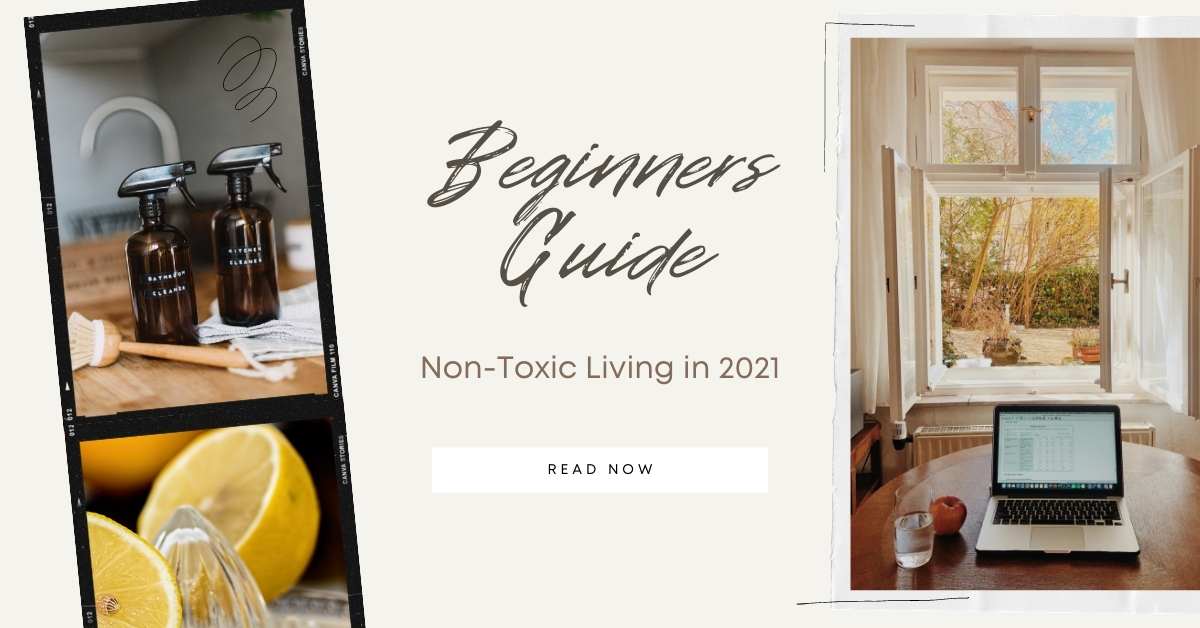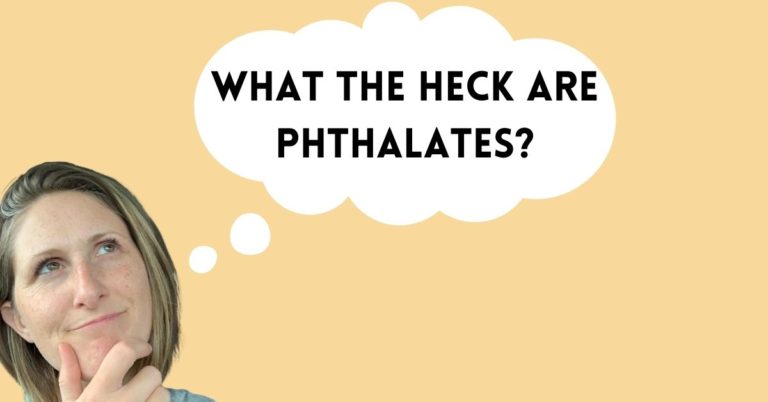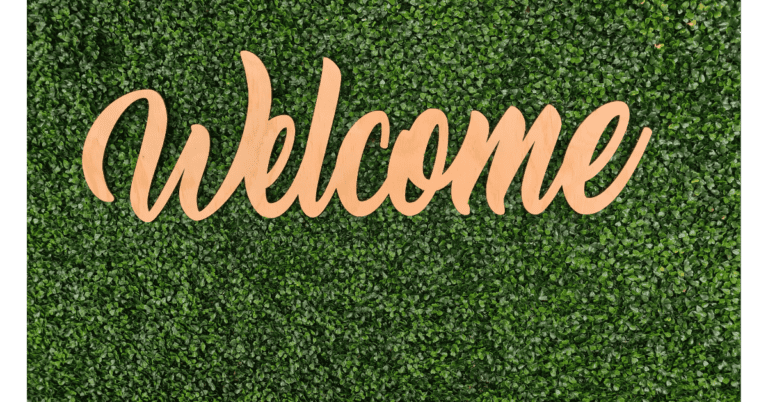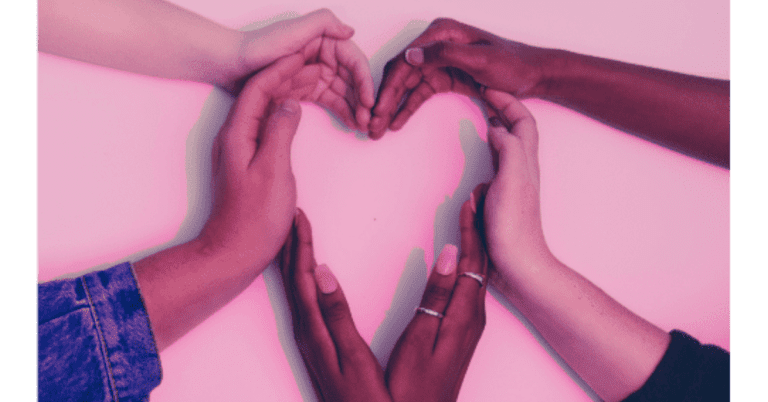The Beginners Guide to Non-Toxic Living in 2022
This guide will help you navigate how to start making the switch to non-toxic living. I’ve researched the topic extensively and started consciously purchasing non-toxic products 10 years ago. I want to save you time by letting you know how to go about this process in an easy, simple, and stress free way!
The Beginners Guide to Non-Toxic living in 2022
About 10 years ago I got sucked in to watching an informercial for 100% Pure Cosmetics. During the segment, the owner was talking about high-performing, nontoxic ingredients they use and how other popular products in the marketplace include ingredients that could be a hazard. This shocked me! I thought anything being sold by a company would be safe, and as I investigated I found out this was sadly wrong:
“Toxic chemicals in our cosmetics, sunscreens and skin care products have gone unregulated as far back as the Great Depression. While other countries have taken action to protect their citizens from chemicals linked to cancer and reproductive harm, the Food and Drug Administration doesn’t even require the basic safety testing of ingredients in personal care products before they’re used”
Environmental Working Group
According to the Environmental Working Group (EWG), just with personal care products, women are exposed to 168 chemical ingredients per day. This doesn’t even include cleaners, and household items so exposure per day goes up. Depending on the product, an ingredient could have a long-term exposure hazard linked to:
- Cancer
- Endocrine-disruptors (affects proper function of the body’s hormone system)
- Development and Reproductive Harm
- Allergies
- Immune System Harm
- Asthma
- Environmental Hazards
What is Non-Toxic living?
Non-toxic living is making conscious decisions to limit the exposure to ingredients or chemicals that could harm your health of you and your family. This applies to all areas of your life like personal care items (makeup, skincare, haircare, sunscreen) food, drinks, cleaners, household items, and pesticides. A way you have control of limiting your exposure is by choosing products that have safer ingredients.
Here are some common Non-Toxic living misconceptions:
- A product is safe if a store is selling it.
- False, there is a lack of regulation in the United States.
- It’s expensive.
- Depends on the product, you have options. You could purchase non-toxic products from the drugstore or choose a luxury brand. You can also save money by doing DIY recipes.
- They don’t perform as well.
- False. There are so many amazing brands out there, and we now have the option to purchase high-performing products at various price ranges.
How to get started with Non-Toxic Living
- Check out the top 17 ways to reduce toxic exposure.
- Be aware of where you are potentially exposed to the most toxins:
- The air we breathe
- The water we drink
- The food we eat
- The personal care products we use: Makeup + Skincare + Haircare + Sunscreen + Bug Spray
- The products in our household and environment: Cleaners + Cookware + Air Fresheners + Candles + Mattresses + Electromagnetic radiation
- Prioritize which areas in your life you want to start switching to non-toxic options. Start with what you do or use daily. Here are areas to focus on:
- Air quality
- Water Quality
- Food
- Personal Care Products
- Cleaners
- Household items
- When you run out of the product, purchase a replacement product with better nontoxic ingredients. Steps to do this:
- For personal care products, search EWG’s Skin Deep database and find products with low ranking hazard scores based on ingredient safety. You can also download the EWG’s Healthy Living app and scan the product barcode when you are at the store and it will show you the hazard rating. Start by searching for the product you normally use since it could be low ranking and you may not want to replace it.
- If you are looking to replace your cleaners, go here to look up products with low ranking hazard scores.
- Decide what hazard level you are comfortable with
- Read reviews before making a purchase to see if people have good results with the product. My favorite place to read reviews for personal care products is MakeupAlley and Amazon.
- Before you purchase, check the return policy. You want to be able to return the product in case it doesn’t work for you.
- For personal care products, search EWG’s Skin Deep database and find products with low ranking hazard scores based on ingredient safety. You can also download the EWG’s Healthy Living app and scan the product barcode when you are at the store and it will show you the hazard rating. Start by searching for the product you normally use since it could be low ranking and you may not want to replace it.
- Instead of purchasing the product, make the product using a DIY recipe.
Tips for Success in Non-Toxic Living
- Do not stress or go about this process with fear being your reason for wanting to make the switch. I would absolutely love if we didn’t even need to talk about non-toxic living because we could count on all our products being safe for us. Just think of it as an opportunity to make a healthier purchase where maybe you decide to just switch out one item like your water filter. Any change you make is great, and if you don’t make any that’s ok too! This is all about living a healthier lifestyle and stress is not good for us, so stressing about ingredients in your products isn’t healthy!
- Slow and steady wins the race. Don’t overwhelm yourself and strain your wallet by trying to switch everything at once. I’ve been at it for 10 years and I’m still updating my products.
Common Questions/FAQ About Non-Toxic Living
How do I start creating a non-toxic home?
- Once you run out a product, replace with another product that has safer ingredients. Here are some common ways to start creating a non-toxic home:
- Air: Get rid of air fresheners since they add to indoor pollution, have plants in the house, avoid products with fragrance listed as an ingredient, open windows to circulate the air, get an air filter. Read more about this topic here:
- Water: Test your water for lead. Get a water filter.
- Food: Use glass containers for storage instead of plastic, avoid Teflon cookware, buy organic
- Personal Care Products: When you run out of your product, replace with a products that offers safer ingredients
- Cleaners: Create DIY cleaners
- Candles: Use beeswax candles instead of paraffin candles
- Laundry: Use wool dryer balls instead of dryer sheets
- Shower: Use a PVC free shower curtain
- Bedroom: Use an organic mattress, pillow, and sheets
How do I switch to non-toxic living on a budget?
- I created 7 tips to non-toxic living on a budget, check it out here!
- Making the switch to non-toxic living can be done on a budget and one of the best ways it to only replace a product once you run out of what you currently have. Other suggestions for budget friendly options:
- Food: Only purchase organic for items listed in the dirty dozen list since they have high pesticides. Use a cast iron pan for cooking, they are durable and last a long time.
- Cleaners: Create your own using common household ingredients like white vinegar and baking soda
- Home: Open windows instead of using air fresheners, take off your shoes when you enter the home so you aren’t tracking chemicals in to your house. Reduce your exposure to EMFs by turning off your internet at night.
- Beauty: One of my favorite ways to save money is to use coconut oil as my face wash and makeup remover
- Making the switch to non-toxic living can be done on a budget and one of the best ways it to only replace a product once you run out of what you currently have. Other suggestions for budget friendly options:
What toxic ingredients should I avoid?
- There’s a lengthy list of ingredients to avoid and here are just a few of them:
- Phthalates: Found in personal care products, food/drinks with plastic packaging, dairy and meat when animals were exposed, and household furnishings. According to safecosmetics.org, phthalates can be linked to “endocrine disruption, developmental and reproductive toxicity, and cancer, have been banned from cosmetics in the European Union, but still remain prevalent in U.S. products.”
- Parabens: A preservative found in personal care products. Safecosmetics.org lists the health concerns associated with parabens which include “endocrine disruption, cancer, developmental and reproductive toxicity.”
- Triclosan: An antimicrobial that kills bacteria and can be found in soaps and detergents, deodorants, toothpaste, cutting boards and other household products. Safecosmetics.org lists the health concerns associated with triclosan as “Endocrine disruption, triclosan-resistant bacteria, environmental toxicity. It’s restricted in cosmetics in Canada and Japan; triclocarban is restricted in cosmetics use in the European Union and is classified to be toxic or harmful by the Environment Canada Domestic Substance List. The EPA regulates triclosan as a pesticide”
- Fragrance: Found in a majority of personal care products and these are considered hidden toxins since companies aren’t required to list the ingredients that make up the fragrance. Safecosmetics.org notes “The International Fragrance Association (IFRA) lists 3,059 materials that are reported as being used in fragrance compounds. Of these 3,059 ingredients, some have evidence linking them to health effects including cancer, reproductive toxicity, allergies and sensitivities.”
- Oxybenzone: Found in sunscreens and according to The Good Face Project it’s “a hormone disruptor. There is moderate scientific evidence that it disrupts endocrine and thyroid hormone balances. Oxybenzone is bioaccumulative, which means it’s absorbed into the body at an unhealthy rate, and accumulates in tissues” and organs. It is also an environmental contaminant that causes coral bleaching and damages reefs.
What are the best non-toxic makeup brands?
- W3ll People
- Mineral Fusions
- 100% Pure
- Honest Beauty
- Juice Beauty
- Vapour Beauty
- RMS Beauty
- Kjaer Weiss
- Ilia
- Lawless
- Beauty Counter
- MyChelle
- Alima Pure
- Rejuva Minerals
How can I clean my house without harmful ingredients?
- There are so many DIY recipes out there to get you started. Have the following ingredients in your cleaning kit and you can create some safe, effective, and budget friendly cleaners!
- White vinegar
- Liquid Castile Soap
- Baking Soda
- Hydrogen Peroxide
- Lemons
- Spray bottle
- Here are some recipes from Mama Natural, Environmental Working Group, Wellness Mama
- If you want to purchase a safer cleaner, purchase one of the low hazard products on the Environmental Working Group site or one of their EWG VERIFIED™ which according to their site are “product goes above and beyond its green rating from EWG, disclosing more about its formulations and manufacturing processes, and ingredients that are seldom listed on product labels.”
The Last Thing You Need to Know about Non-Toxic Living
Everyday we can make a conscious decision on how we choose to live a healthy lifestyle, and one of these ways is to use non-toxic products, eat organic, and filter your water. It will be a work in progress and be proud of any changes you end up making, even if it’s just switching out one item. Please share with anyone else that you think may want to make some changes.
Cheers to the journey!




